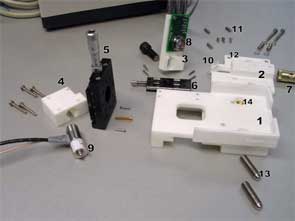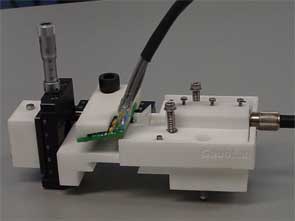| Posted: Aug 01, 2007 | |
Print your atomic force microscope |
|
| (Nanowerk Spotlight) You might remember our Spotlight from a few months ago ("25 years of scanning probe microscopy and no standards yet") where we gave an overview of how scanning probe microscopy has flourished over the past 25 years. | |
| The most versatile implementation of the scanned probe principle is the atomic force microscope (AFM). It has become one of the foremost tools for imaging, measuring and manipulating matter at the nanoscale. The essential part of an AFM is a microscale cantilever with a sharp tip (probe) at its end that is used to scan the specimen surface. | |
| The cantilever is typically silicon or silicon nitride with a tip radius of curvature on the order of nanometers. When the tip is brought into proximity of a sample surface, forces between the tip and the sample lead to a deflection of the cantilever according to Hooke's law. A multi-segment photodiode measures the deflection via a laser beam, which is reflected on the cantilever surface. | |
| Because there are so many promising areas in nanotechnology and biophysics which can be examined by AFM (force spectroscopy on DNA, muscle protein titin, polymers or more complex structures like bacteria flagella, 3-D imaging, etc. ) the availability of instruments is crucial, especially for new groups and young scientists with limited funds. The price tag of AFMs runs in the hundreds of thousand s of dollars, though. | |
| Until now, AFM heads are made of metal materials by conventional milling, which restricts the design and increases the costs. German researchers have shown that rapid prototyping can be a quicker and less costly alternative to conventional manufacturing. | |
| "We have used a rapid manufacturing technique called 'selective laser sintering' as a method to produce components for scientific setups in a very fast and easy way" Prof. Hermann E. Gaub explains to Nanowerk. "This method, already widely used in prototyping and design, is a very cost efficient rapid prototyping approach that offers a quasi-instant realization of new design ideas and allows us to test and evaluate a wide range of novel conceptual options." | |
| Gaub, head of the Biophysics and Molecular Materials Group in the Physics Department at the Ludwig-Maximilians-University of Munich (LMU), and a spokesperson for LMU's Center for NanoScience (CeNS), together with other CeNS group members, applied a rapid prototyping technique to manufacture an AFM head and compared its performance with a copy milled from aluminum ("Print your atomic force microscope"). | |
| Selective Laser Sintering (SLS - a registered trademark of 3D Systems, Inc.) is an additive rapid manufacturing technique that uses a high powered laser to fuse small particles of plastic, metal, or ceramic powders into a mass representing a desired 3-dimensional object. The laser selectively fuses powdered material by scanning cross-sections generated from a 3-D digital description of the part (e.g. from a CAD file or scan data) on the surface of a powder bed. After each cross-section is scanned, the powder bed is lowered by one layer thickness, a new layer of material is applied on top, and the process is repeated until the part is completed. | |
| "To evaluate the performance of a rapid prototyped AFM, we reprinted one of our aluminum AFM heads with the SLS method in plastic" Robert Lugmaier, a co-author of the paper, explains. "To compare the noise and drift values of these AFM heads under equal conditions, the same optical and electrical components were used. The laser diode, the piezoactuator, and the photodetector were identical for the plastic printed as well as the aluminum milled AFM." | |
  |
On his website, Lugmaier has posted a tutorial "How to build a Plastic-AFM head" for building a cheap and simple AFM head suitable for single-molecule force spectroscopy. The white parts are printed plastic components replacing the milled metal parts. (Images: Robert Lugmaier, LMU Munich) |
| In force spectroscopy the accuracy of the force measurement is ultimately limited by thermal noise of the cantilever. Resonant modes of the instrument or electronic noise can worsen the sensitivity drastically. | |
| "We compared the performance of our printed plastic AFM head with a copy milled from aluminum. We tested both AFM heads for single molecule force spectroscopy applications and found little to no difference in the signal-to-noise ratio as well as in the thermal drift" says Lugmaier. "In terms of long-term drift, the printed AFM performed favorably, presumably because of the lower expansion coefficient of plastic." | |
| He points out that the plastic head is clearly not as durable as the metal instrument concerning mechanical load and solvent resistance. "But this very cost efficient rapid prototyping approach offers in turn a quasi-instant realization of new design ideas and allows us to test and evaluate a wide range of novel conceptual options." | |
| "This approach promises innovative means to explore new AFM operation modes, particularly in combination with other high resolution techniques such as single molecule optics, patch clamps, and alike" says Gaub. | |
| The LMU team currently uses their laser-sintered AFM-head in one of their labs for single-molecule studies. "We were able to equip the newly founded partner lab of a junior professor, spending only a fraction of the cost of commercially available AFM products" says Lugmaier. "This ultimately enables research groups (especially diploma and Ph.D. students) to spend more time with otherwise expensive equipment and examine the molecules of their interest." | |
 By
Michael
Berger
– Michael is author of three books by the Royal Society of Chemistry:
Nano-Society: Pushing the Boundaries of Technology,
Nanotechnology: The Future is Tiny, and
Nanoengineering: The Skills and Tools Making Technology Invisible
Copyright ©
Nanowerk LLC
By
Michael
Berger
– Michael is author of three books by the Royal Society of Chemistry:
Nano-Society: Pushing the Boundaries of Technology,
Nanotechnology: The Future is Tiny, and
Nanoengineering: The Skills and Tools Making Technology Invisible
Copyright ©
Nanowerk LLC
|
|
Become a Spotlight guest author! Join our large and growing group of guest contributors. Have you just published a scientific paper or have other exciting developments to share with the nanotechnology community? Here is how to publish on nanowerk.com.
